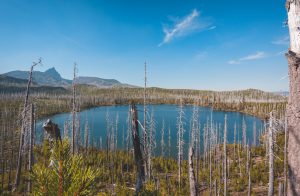Define Retention Ponds
Retention ponds refer to an artificial (man-made) pond. This pond is usually surrounded by vegetation. A Retention Pond can be dry or wet (by classification).
Control Of Water Flow & Pollutants, Protects The Environment
The result of rainfall is storm water run-off. This storm water run-off needs to go somewhere. The storm water runs into sewers, streams, and rivers. Storm water run-off can cause severe erosion and pollution. The cost to correct erosion and pollution can be expensive. Retention Ponds alleviate the expense of erosion and pollution. The intent of Retention Ponds is to reduce land erosion and pollution. As for pollutants, retention ponds are important in the removal of pollutants from the storm water run-off.
2 Types Retention Ponds (Dry & Wet)
- A dry pond, is one that contains no permanent pool of water. The dry pond, has a water inlet level or water collection manifold (a drain) at the bottom. This water inlet system, permits all water running into the Retention Pond to run out. This drain system can be made of PVC, metal or concrete, which can be called a riser.
- A wet pond, contains a permanent body of water. This permanent body of water is achieved with an higher inlet level, which allows for a permanent body of water.
6 Benefits Of Retention Ponds:
- Reduce erosion damage to the Environment.
- Removes pollutants from the storm water run-off.
- Provides for a healthier Environment.
- Improves conservation of wildlife.
- Enhances the landscape beauty to the region.
- Improved water quality.
How Retention Ponds Work
The purpose of retention ponds is to remove sediment from the storm water. The removal of materials like heavy metals, particulates, wooden materials, and organic matter, protects the Environment. The aquatic plants eliminate soluble substances, dissolved metals and nutrients. This process is called biological uptake.
Retention ponds carry out treatment by absorbing energy from the storm water run-off . This helps to reduce the scour materials from eroding adjacent land area. The reduction of scour materials and the filtration of incoming storm water, reduces damage to the Environment.
Aquatic vegetation, plants and grasses in water help to withhold and or filter out the pollutants from the storm water. This filtration protects the quality of water, an important natural resource.
Bio Mix Soils is an important component of Retention Ponds. To find out more about “bio mix soils designs” contact your local building permit office.
Composition Of Bio Mix Soils
Bio mix soils mostly comprise of sand and organic matter with a sizable amount of clay and silt. The sand aids drainage of the system. Sand helps to prevent potentially destructive floods and allows for water run-off. This water run-off is usually directed to the nearest water body. The clay and silt help in removing the nitrogen, phosphorus, potassium, and any other polluting elements. Organic matter helps to break down the toxic contents of storm water run-off through the process of aerobic decomposition.
Where To Find Bio Mix Soils

Proper storm water run-off flow and pollutant removal system in a retention pond is a must, to maintain the Environment. Do you need Bio Mix Soils for your retention pond project? Dirt Connections is just the place for you. Dirt Connections can provide you with your unique Bio Soils Mix. Want to know more about Dirt Connections? Contact the company at www.dirtconnections.com/contact/ today!
Make an order online for bio mix soils for your retention pond at Dirt Connections today.
8 Advantages and Benefits of Retention Ponds
- Retention ponds improve water quality.
- Remove pollutants and sediments.
- Serve as storage facility for controlled release of water.
- Diminish the threat of flooding.
- Enhances the Environment and wildlife
- Easy to construct and maintain if adequate space is available or provided.
- Beautification to the landscape.
- In some cases provides for parks and recreation.
Other Retention Ponds Benefits:

- Biodiversity preservation
- Flood risk reduction
- Better protection for ecosystems and optimum use of Green infrastructure
- Storage of run-off
- Reducing the rate of run-off
- Interception of pollution pathways
- Creating aquatic habitat
- Pollutants Filtration
- More sustainable forestry and agriculture
- Create terrestrial habitat (with the natural vegetation along the perimeter)
- Enhancement of precipitation
- Reduction of peak temperature
- Erosion and sediment control
- Creation of enhanced shore line habitat
Retention Pond Inspections
The inspection of Retention Ponds, can be completed by Federal, State and local, city or county officials. Below is a general checklist of items you should be aware of for compliance and general maintenance:
- Ensure the earth and embankment around the retention pond are in proper condition.
- Look for healthy vegetation surrounding the retention pond.
- Always check for debris which may have accumulated over time in your retention or detention pond.
- Pass your knowledge on to your neighbors, tenants or homeowners in the residential or commercial space. Be sure everyone understands the importance of reducing the number of toxic chemicals and wastes.
- Regularly inspect the banks, the exhaust, the head wall, and other vital components that make up the retention pond or basin. Be sure the pond is in good working condition.
- Check and remove any sediment or silt that may have accumulated overtime.
- Carry out regular inspections on the channels, gutters and storm water drain. Be sure the retention pond is free from sedimentation and debris.
Materials like pet waste, grass clippings, and other organic materials that find passage into the various storm water drain provide algae to grow at a rapidly. This algae growth, will demand increased maintenance, to keep the retention pond in good working order.
Proper maintenance of your detention or retention ponds or basins allows storm water runoff is a must. A retention pond filled with debris or toxic pollutants can post a liability to you and your association. Proper maintenance of your Retention Pond is paramount. Liability to the Environment, can expose you or your association to liability.
Get the Best Bio Mix Soils For Your Retention Pond
Get bio mix soils! This special mix of sand, silt, clay, and organic matter will give your retention pond a super-filtering and super purifying effect. To reduce storm water run-off it is important to install Bio Retention Ponds properly. For your unique bio soil mix design, contact your local building permit department for Build Code Compliance.
Best Bio Mix Soils for Retention Ponds
Choosing the best bio mix soils is crucial for an effective retention pond. Bio mix soils, including sand, silt, clay, and organic matter, enhance water filtration and pollutant removal. This special mix helps manage storm water run-off and improves water quality. By incorporating high-quality bio mix soils, you ensure better control of pollutants and a healthier environment. For top-notch results, use bio mix soils from trusted providers. Discover how the right bio mix soils can optimize your retention pond at Dirt Connections.
Where Can You Get the Best Bio Mix Soils?
Dirt Connections, is your number one company for bio mix soils. Dirt Connections will work hand in hand to get the best quality custom mix for you. Place your order now? Get more information or make your order at:











































